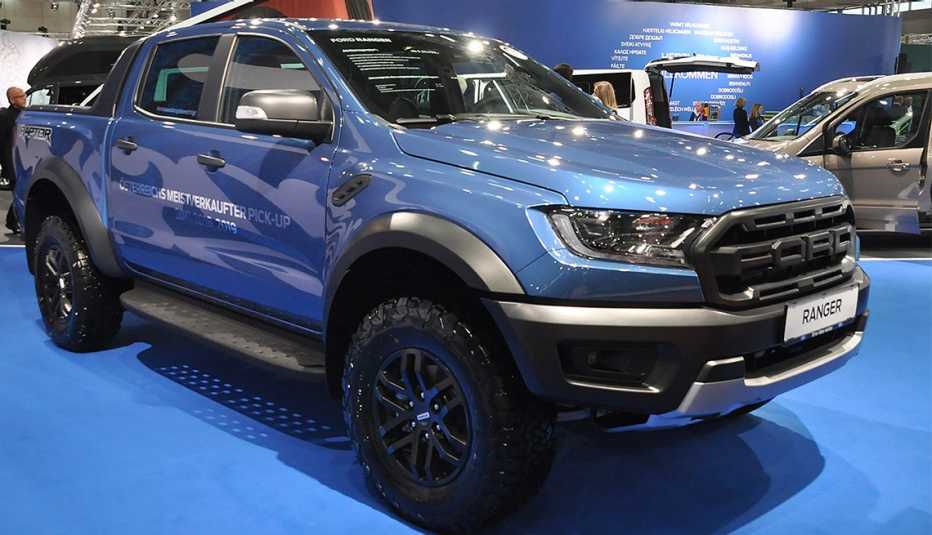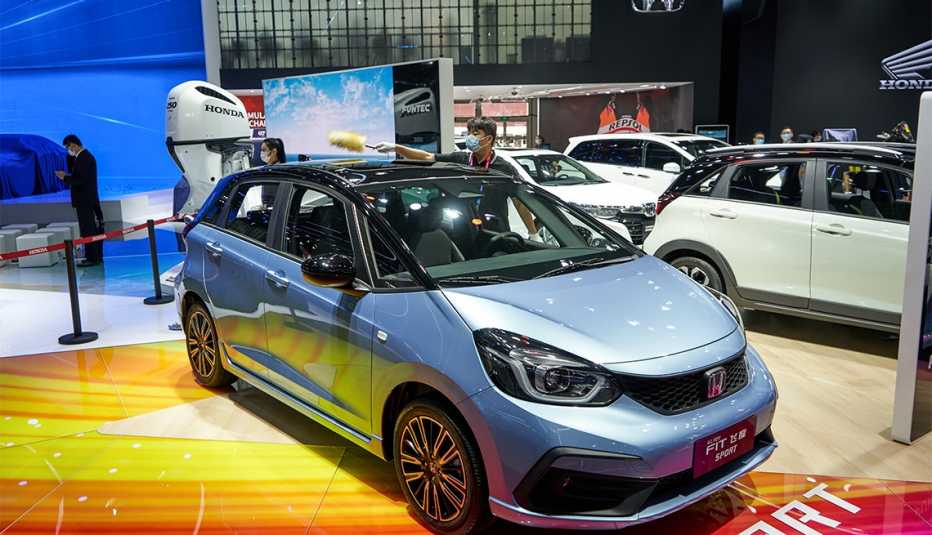AARP Hearing Center
A lot of sage advice says you're better off buying a used car than a new one.
Is a new car ever a good idea, especially now when the pandemic has hampered factory production and new car inventories are down, meaning prices are up? If you're in a position to be car shopping, then, yes, consider certain new cars instead of their used counterparts, says iSeeCars.com, which tracks car statistics — prices, accumulated miles and so forth — with its multimillion-vehicle database.
Some new models depreciate so little their first year that you might as well buy new to get the full warranty. Plus rebates and zero percent or super-low-interest loans are sometimes available on new cars but not on used.
Yet some one-year-old luxury vehicles, especially some BMWs, are far better buys used because they lost so much in value their first year, the data firm says. iSeeCars, which has its headquarters in the Boston suburb of Woburn, uses the term “lightly used,” meaning roughly 13,000 miles.
It compares and contrasts data on tens of millions of vehicles, such as this new vs. used evaluation. This data was analyzed in March before the coronavirus pandemic had caused shortages of both new and used cars, pushing up their prices. While a specific average price might have changed in the meantime, the percentages between new and used prices — the depreciation — is likely to be about the same, iSeeCars officials say.
Some luxe cars don't hold value
The jaw-dropper is the BMW 7 Series, according to iSeeCars data. Remember, the data is an average and doesn't refer to any specific version of the 7 Series.
The company's data analysis includes 2018 and some 2019 models all sold used. It shows an average new price for the 7 Series is $109,231. Average price after a year: $61,784.
The big, luxurious 7 Series is chock-a-block full of features and power, and the base price for the least expensive model new is about $87,000. So it's a lot of car for about $62,000, even at a year old.
"Super luxury cars like the BMW 7 Series take large depreciation hits due to their high starting prices, which is coupled with the car [7 Series] being redesigned in 2020 to automatically date 2019 models,” iSeeCars Chief Executive Phong Ly says.
Put simply, “You'll be able to get a cooler car for less money,” Motor Trend commented a year ago in an article on luxury car depreciation.
In addition to the 7 Series, BMWs on the buy-used list are the 3 Series; 4 Series; and the X6, a crossover SUV with a hatchback-sedan body. Five others on the list also are luxury makes. The only exception is a Chevrolet Camaro.
A big drop in value the first year is a negative to new-car buyers. But it's a plus to used-car bargain hunters.
A year-old car, which is what we're discussing here, will have some or most of the automaker's original warranty, usually 3 years or 36,000 miles though exceptions do exist. And a yearling still could have some of the free maintenance that some manufacturers offer.
BMW cut its free maintenance to three years, from four, on 2017 and newer model vehicles and reduced the number of items covered. Keep in mind that most 2020 models are still considered new in this study though many now are being replaced in showrooms with 2021 models.
Some models are better deals new
When a vehicle loses little value in its first year, a new one is a good bet. Sometimes a car holds its value if it was recently redesigned or had other changes that could slow depreciation.
Four Hondas are on iSeeCars’ buy-new list, and most of the others are likewise mainstream models. Two big exceptions: Tesla's Model 3 luxury electric sedan drops a scant 5.5 percent its first year, putting it atop the buy-new list. The Chevrolet Corvette is No. 7, dropping 13.6 percent the first year.
The Ford Ranger mid-size pickup, reintroduced to the U.S. as a 2019 model, is No. 2. iSeeCars was able to tease out enough Ranger details for AARP so we can use it as an example to show how averages can camouflage extremes.
The top-end Ranger Lariat drops 19.4 percent to $33,125 its first year. The XL, the base version, drops 7.4 percent to $29,795.
Why? Lariat is loaded with leather upholstery, heated seats and a heated steering wheel, a luxury stereo and other features alluring to new vehicle buyers but less exciting in the used-vehicle market, according to iSeeCars. The numbers here are averages of some 6 million transactions that iSeeCars tracked.
Used-car bargains


1. BMW 7 Series. Average new price, $109,231. One-year depreciation, 43.4 percent. Average year-old price, $61,784
Our take. Great bargain on a feature-filled sedan, but, “usually, a car that costs a lot of money to buy will cost a lot of money to maintain,” auto-enthusiast website Hotcars.com notes.


2. Audi A6. Average new price $63,931, One-year depreciation, 41 percent. Average year-old price, $26,199
Our take. Consumer Reports calls the interior “a delight,” but the magazine's reliability rating for the A6 of just 1 on a 5-point scale is off-putting even though its owner satisfaction score is a commendable 4 of 5.


3. Jaguar XE. Average new price, $50,371. One-year depreciation, 40.9 percent. Average year-old price, $29,786
Our take. A fun-to-drive compact luxury sedan that gives us second thoughts because its reliability and owner satisfaction scores both are low, Consumer Reports says: 2 out of 5.


4. Volvo S90. Average new price, $58,970. One-year depreciation, 40.1 percent. Average year-old price, $35,339
Our take. We are skeptical. While CNET's Roadshow auto review publication likes its looks and solid feel, it cautions, “Some of the tech is unintuitive, and this is not a driver's car."


5. BMW 3 Series. Average new price, $50,369. One-year depreciation, 38.2 percent. Average year-old price, $31,128
Our take. A Consumer Reports’ reliability rating of 1 out of 5 puts a wrench in the works. The 2012 to 2018 models scored better. Apparently, the 2019 has tempting upgrades such as improved handling and good fuel economy, but dependability has to be a part of that list.
6. Chevrolet Camaro. Average new price, $44,492. One-year depreciation, 37.8 percent. Average year-old price, $27,663
Our take. We wonder what the Ford Mustang and Dodge Challenger — Camaro's direct rivals — did differently to avoid such a steep fall in value. Even though they're not on the list, we would check their year-old prices, too, if we were shopping for a used sporty coupe. Buoying that: Consumer Reports’ reliability scores differ, showing Mustang at 3 of 5 and Challenger at 5 of 5 in recent model years. Camaro: 1 of 5.
7. BMW X6. Average new price, $84,042. One-year depreciation, 37.7 percent. Average year-old price, $52,387
Our take. First, this SUV is not for everybody. It has a hatchback-like sedan body, giving you a less-roomy interior than a “real” SUV but clearly provides visual distinction. A Mercedes-Benz GLA is a similar take, though smaller. Even after the BMW's steep depreciation, it still seems pricey to us. Consumer Reports posts no reliability scores on older versions but forecasts that the 2020 will come in at 2 of 5.
8. Land Rover Ranger Rover Evoque. Average new price, $56,507. One-year depreciation, 37.3 percent. Average year-old price, $35,427
Our take. To understand the cumbersome name, know that Land Rover's the parent brand, Range Rover is the luxury line within that brand and Evoque is the oh-so-highly-styled model. U.S. News & World Report, which looked at reviews from 45 other publications, calls it a “so-so” luxury subcompact SUV. That amalgamation also shows subpar reliability ratings. The 2020 redesign provided more rear legroom and more standard infotainment features.
9. Mercedes-Benz CLA. Average new price, $42,793. One-year depreciation, 37 percent. Average year-old price, $26,955
Our take. A Mercedes for $27,000 is tempting. But owner satisfaction has been poor though reliability has been OK, 3 out of 5, Consumer Reports says. And it's smaller than the BMW X6, above, possibly too small for some needs, especially in the trunk.
10. BMW 4 Series. Average new price, $52,951. One-year depreciation, 35.8 percent. Average year-old price, $33,991
Our take. Dependability is a strong point here, 4 out of 5, according to a U.S. News article that cites consumer survey veteran J.D. Power and Associates. The cars are what once would have been called a 3 Series coupe, spawned into its own space of two-door models.































.jpg?crop=true&anchor=13,195&q=80&color=ffffffff&u=lywnjt&w=2008&h=1154)






































